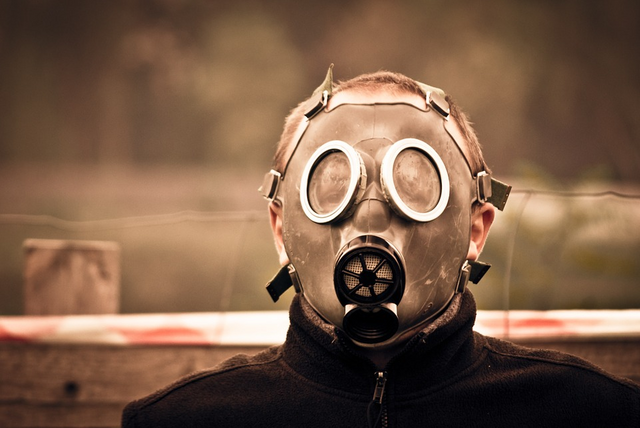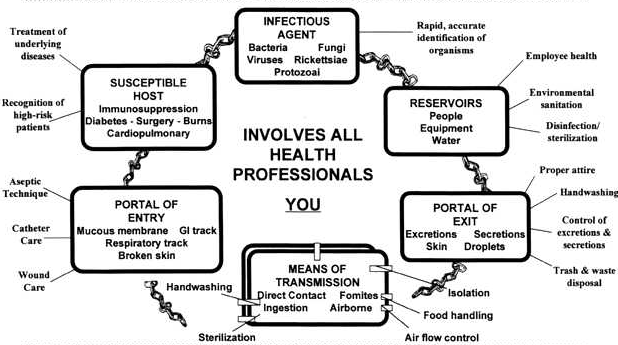All About Infection: A health concern that needs attention!
Infectious disease are any diseases that is due to the proliferation of pathogenic microorganism in the body. But infection may or may not be communicable or in other word contagious. Modern technologies have made a way to control, eradicate, and even lessen the occurrence of many infectious diseases. However, increases in the incidence of other infections, such as those caused by antibiotic-resistance organisms and emerging infectious diseases, are of growing concern.


Fig. 1
As a nurse by profession, I know that I can contribute an important role in infection control and prevention. Teaching my patients proper ways to maintain the integrity of their health may decrease the risk of becoming infected or may decrease the spread of infection. Promotion and use of appropriate barrier precautions, observing prudent hand washing, and ensuring aseptic care of intravenous (IV) lines and other invasive equipment also assist in reducing infections.
The Infectious Process
The chain of infection is a complete chain of event needed for infection to occur. Six elements are necessary, including a causative agent, a reservoir of available organisms, a portal of exit from the the reservoir to the host and a mode of transmission from the reservoir to the host and a mode of entry into a susceptible host.

Fig. 2
Nurses should understand each and every part of the cycle in order to identify points at which they can perform nursing interventions to interrupt the chain, thus protecting the patients, themselves, and others from infectious diseases.
Causative Agent/Organism - The types of microbes that cause infections are bacteria, viruses, protozoa, fungi, helminths, and rickettsiae.
Reservoir - the term used for any person, plant, animal, substance, or location that provides nourishment for the microorganisms and enables further dispersal of the organisms. Infections may be prevented by eliminating the causative organisms from the reservoir.
Mode of Exit - an infected host must shed organisms to another or to the environment for transmission to occur. Organisms exit through the respiratory tract, the gastrointestinal tract, the genitourinary tract, or the blood.
Route of Transmission - it is to connect the transmission of the infectious source of the organism to it's new host. It can be transmissible through sexual contact, skin-to-skin contact, percutaneous injection, or infectious particles carried in the air.
Susceptible Host - for the transmission to be successful, the host needs to be susceptible, like a person who is immune-compromised, then the success rate of the transmission is high.
Portal of Entry - this is the access of the microorganism to infect the host. That means microorganisms have specific portal of entry, a causative agent that can infect the lungs, does not mean that it can infect the skin.
There are parts of our body that are considered sterile. Bacteria found throughout the body usually gives positive effects. These are named normal floras, but they have to stay in a specific system to maintain function. Failure of keeping this intact may cause an opportunistic infection. For example, E. coli a flora that is normal inside our gastrointestinal system, but may cause infection in the genitourinary tract.
Colonization is a term used to the growth of microorganisms without interference or interaction. This is use to identify the specific microorganisms. Accuracy of the identification is very important, as this will be uses in the Culture and Sensitivity exam, to identify effective treatment for the infected host.
If infection occurs, then that just means that there is an interaction between the agent and the host. If a patient suffers from an infection it is important to identify first the type of microbes it has, as I've discussed earlier, it's important to identify the organism to provide an appropriate treatment.
Control and prevention is a vital intervention needed to contain the agents. There are protocols and guidelines provided by the World Health Organization that should be strictly followed. Hospitals, Clinics or any other Health Facility are required to submit to these guidelines. These are monitored by the local counterparts of World Health Organization. Inspection, and thorough reports of the records of hospital acquired infections/health care-associated infections as the result of these may cause a closure of a health facility.
So there are methods invented to prevent Infections acquired in Hospital setting. Isolation precautions guidelines created to halt the transfer of microorganisms to a host. There are two tiers of precautions according to the Healthcare Infection Control Practices Advisory Committee (HICPAC).
The first one is standard precaution, the area are composed of people colonized by the same infectious agent, they may or may not manifest sign and symptoms, but the same level of infection controls is being executed for everyone. The use of masks, gloves, goggles, and gowns are required depending on the level of contagiousness. Hand washing is then observed as this is the most universal thing to do to prevent cross contamination.
The second one is transmission-based precaution, there are organism that are highly contagious, that we have to combine standard precaution, a higher-based precaution, and transmission-based precaution to counter. This will be used especially if the microorganisms can be transmitted through droplet, airborne and contact.
Now we should focus on preventing infection in the community, as it is the most prone subject in acquiring infection. There are actually ways and means the Government and World Health Organization to prevent, and contain such existing ill-causing microorganisms. This is a responsibility that needs great attention, as this will define the health state of one nation.
Vaccination programs have aroused to contradict such diseases, but we have to know that there some vaccines that can cause a specific disease to come out, so it has to be thoroughly studied and tested, to protect the welfare of the community. Say for example the DengVaxia a dengue vaccine used in the Philippines during the last administration, that caused death to a lot of children in the north. I will not tackle the totality of it, but this will just serve as an example, a timely one, that vaccines may brought danger or safety.
As Nurse, I would like to highlight that there are actually things that we can contribute in the combat against infection, and it's time to be responsible in knowing the things we can do when it comes to infection. As health care providers it is our task to resonate out compassion to the public through health education.
"Be Educated, Be Aware, Be Healthy"
Sources:
Cover:
Image Source(direct link to img)
Fig. 1:
Image Source(direct link to img)
Fig. 2:
Image Source(direct link to img)
By typing @steemgigs as your witness, just click -> https://steemit.com/~witnesses
God Bless!

Thank your for your educational post
you're welcome :)